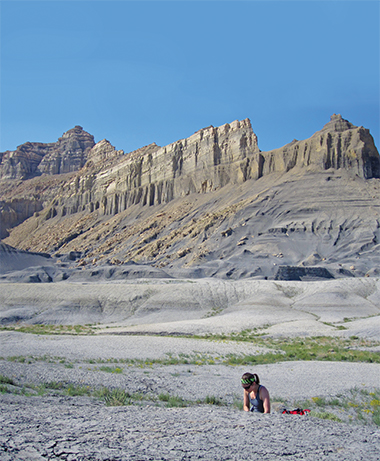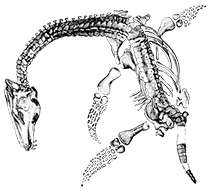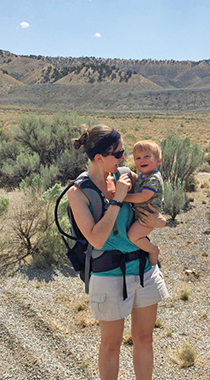Unpacking a Plesiosaur
- Unpacking a Plesiosaur
- Path to Paleontology
- Rebecca McKean Reflects on Working in the Field with a Toddler in Tow
Unpacking a Plesiosaur
Confirming a new species is not something that happens in a lightbulb moment, and no one knows this better than Rebecca (Schmeisser) McKean ’04 (Geology).
It’s been six years since McKean spotted some particularly interesting bone fragments while surveying the Grand Staircase-Escalante National Monument in Southern Utah. … Five years since her plesiosaur was finally excavated from the Tropic Shale, its bones packed into two large plaster jackets, one small jacket and several bags of fragments. … Four years since she was able to bring it to St. Norbert, where the science faculty was still dispersed pending the remodeling of the old John R. Minahan Science Building. … Three years since she was finally able to open the first jacket in her new state-of-the-art prep lab.
This fall, after three more years of diligent work on the shoulder section – three years of toil over bone fragments little larger than dust – McKean is finally face-to-face with her find. She is beginning work on the skull.

Pieces of bone on the ground aren’t uncommon and typically don’t lead to a fossil find, but once McKean located intact vertebrae, and the skull within the hill slope shortly thereafter, she knew she’d found the remains of a prehistoric carnivorous marine reptile from the Cretaceous Period: a 92.5 million-year-old plesiosaur.
“You just never know what you’re going to get in any given field season,” says McKean. “I’ve been out [many times] before and found nothing, but to see that skull in such beautiful condition was so exciting.”
After three arduous years brushing, cleaning and putting together the fossils in the first of her plaster jackets, the one containing the plesiosaur’s shoulder area, McKean is ecstatic that she’s now able to start the same process with the skull this fall. Excavating a complete skull of any specimen is something to celebrate, says McKean, since it’s the part that’s widely regarded as the most reliable path to species identification.
But the entire process requires the utmost patience, both in the field and in the lab, and discovering a fossil worthy of excavation isn’t all that easy either.
McKean’s trips require a prospecting permit that allows her to collect anything on the surface or a few inches beneath the ground. When researchers find specimens larger or deeper than that, they need to apply for a separate excavation permit in order to remove the fossil. This tends to take a full year to process, so the discovery site itself can’t be disturbed.
“It can be nerve-wracking because you don’t have eyes on your site for a whole year,” says McKean. “You worry about big storms that may come through, or further erosion, or even poachers who could steal the fossil.”
It wasn’t until the summer of 2013 that McKean’s plesiosaur was finally excavated, with help from Allison Shackelton ’14 and Shannon Fasola ’14, with Dave Gillette and volunteers from the Museum of Northern Arizona (where McKean currently partners as a research associate). The excavation of this particular specimen presented a unique challenge. It lay in thick shale near the bottom of a cliff where a car-sized boulder had fallen to rest upon it. While sections of the skeleton a few feet from the boulder were fractured, the skull fossil underneath was in pristine condition.
“We later learned this actually improved the quality of preservation by preventing expansion of the shale during weathering,” says Gillette. “The boulder’s weight kept the ground compressed.”
The field team had to tunnel far enough beneath the boulder to make a plaster jacket around the skull. Fortunately, the boulder didn’t shift, the bones remained undamaged and the team safely removed the fossil, which constitutes about 25 percent of a complete plesiosaur skeleton. (It’s incredibly rare to find an entire fossil of any species, explains McKean, and most complete fossils on display are composites of several skeletons.)
The plaster jackets were then transported to the Museum of Northern Arizona for safekeeping for an additional year while work began on remodeling the former science building at St. Norbert. Because of the fragility of the specimens, McKean decided to go to Arizona in 2014, load up the two plaster jackets (one containing the shoulder and the other the skull) and drive them back to Wisconsin herself. Meanwhile, work continued on the new science center with its geology prep lab. McKean had to be patient a little while longer.
Putting the puzzle pieces together

By the time McKean finally cracked open the first jacket in 2015, it had been almost three years since she first laid eyes on her plesiosaur. Revealing the fossils once more, in her brand new lab, was exhilarating. “To have this space is enormous for me. I had a modified setup that worked, but it was so cramped,” she says. “I designed this new space for my research. I have the ventilation, the surgical lights, the table that’s hydraulic – all the bells and whistles of a prep lab that a big research institution has. I would’ve not been able to work on these fossils here if GMS [the Gehl-Mulva Science Center] hadn’t been built.”
With the plaster jacket opened, the fossil preparatory work began. The work includes carefully removing pieces of rock and bone from the jacket, piece by piece, cleaning them with toothbrushes and dental picks, and then gluing the pieces back together.
McKean, with the help of St. Norbert geology students (including her Introduction to Paleontology class), recently finished examining the contents of the first jacket. Its contents were fractured and weathered due to erosion. This jacket contained part of the plesiosaur’s chest, one shoulder, the humerus, the scapula, a coracoid, and several vertebrae and ribs. (The coracoids are two large bones that stretched across the plesiosaur’s chest and helped them maneuver their huge wing-like front flippers, or paddles.)
“When you find tiny pieces that fit, they lock into place and it’s so satisfying,” says McKean. “I’m really pleased with how the first jacket turned out.”
This fall she has started on the second jacket, which contains the full plesiosaur skull. It’s too early to confirm whether or not this plesiosaur is a new species – but it doesn’t resemble anything else that has been found so far in the Tropic Shale, which is compelling in itself.
“I love the prep work because it’s fulfilling,” McKean says. “These bones are 92.5 million years old. It’s amazing because they were in the ground for that long, and I’m the first one to see them since.”
As the work proceeds, McKean compares her reconstructed fossil with other specimens that have been discovered: first, with others from the same rock formation; then, with others on which research has been published. She photographed bones from several plesiosaurs from the Museum of Northern Arizona and generated 3D models so that she could undertake comparative work on campus.
After McKean officially identifies the species and publishes her research, the fossil will be transferred to the Museum of Northern Arizona as required by her permit. Museum staff there catalogue fossils of all kinds and manage them so they are accessible by other paleontologists.
Along with shared time in the field, McKean regularly incorporates hands-on experiences inside and outside the classroom. It’s a chance to introduce St. Norbert students to the hands-on processes of paleontology.
Some of her upper-level students also work in her lab during the semester. They discuss taphonomy (the study of fossilization), talk in detail about preservation, and open plaster jackets to clean fossil pieces. McKean also advises students on their own undergraduate research projects, which might involve examining specimens that they themselves have found while working in the field in Utah with their professor.
Sara Schreder-Gomes ’19, a geology student who’s graduating this December, is currently assisting McKean with fossil prep work.
“Sara asked if she could get more experience, so right now she’s taking bags of fragments, cleaning them up and putting them together to try and identify what we have,” says McKean. “She’s getting that knowledge and making huge progress.”
Schreder-Gomes spends hours in the lab cleaning the fossils and putting them together, but when she finds the perfect fit, she says it’s like no other feeling.
“When I work in the lab I get a little awe-struck just thinking that I have the privilege of being one of the first people to handle this specimen in around 90 million years,” says Schreder-Gomes. “It has its ups and downs. Sometimes I’ll spend an hour in the lab and only find one or two bone fragments that fit together. Other days, I’ll find five or six.”
Coming full circle
As a St. Norbert alum, McKean knows first-hand the immense benefit she and other faculty can bring to their students.
“How cool it’s been for me to be an alum to come back here as a professor and contribute to those same types of student experiences that I was fortunate to have as an undergrad,” says McKean. “Tim [Tim Flood] and Nelson [Nelson Ham] were my professors when I was here and strongly emphasized field-based learning, which had a huge impact on me.”
McKean has worked hard to provide similar field-based opportunities for her students, whether it’s a summer excursion in Utah or a trip elsewhere. She understands that her research can slow depending on how her responsibilities shift from semester to semester, but her most worthwhile moments are when she involves her students in that research and fieldwork. “If I were at a big research institution, I wouldn’t have these experiences that are the most valuable to me and to our students,” she continues. “Faculty-student research for our undergrads is a game-changer, and I know that because it was for me. And, for me personally, it’s way more rewarding instead of just cranking out paper after paper.”
New techniques extend the classroom experience in other ways, too. McKean has experimented with creating digital 3D images of her plesiosaur and others from the Museum of Northern Arizona with photogrammetry, using photography to map and measure objects. With help from Erik Brekke (Physics), she has printed 3D models of these images with his department’s 3D printer. She plans to bring them into the classroom so her students can work with model fossils without having to travel to a digging site or use the lab.
“I found [the plesiosaur], I got to excavate it and I got to bring it here,” she says. “I get to tell its story, whatever that may be, and that is one of the most enjoyable parts of my job.”
Hacker studied fish fossils he uncovered in 2012 under McKean’s tutelage and presented his research at the 2016 National Geological Society of America Conference. After a year of internships in paleontology and geology, he is now in his first year at DePaul University studying cretaceous fish under renowned expert Kenshu Shimada.
Shackelton was on hand to help excavate the plesiosaur in 2013 and also developed research projects on cretaceous fish from the Tropic Shale and pterosaurs while at SNC. She recently finished her master’s program on fossil mammals at Temple University and is starting her second year in a Ph.D. program at Northern Illinois University studying fossil hippos.
Schreder-Gomes vividly remembers the moment she developed a desire to study paleontology. It was SNC Day in 2015, and her mom and grandmother drove six hours to visit her for the first time. She regaled them with tales about her fascinating geology class with McKean while walking through the Gehl-Mulva Science Center. When they came upon the professor diligently working in her lab, she stopped to explain what she was doing – sparking Gomes’ curiosity in learning more about the history of life on Earth.
Rebecca McKean Reflects on Working in the Field with a Toddler in Tow
 Doing field work in the unforgiving desert environment of Southern Utah is hard enough, but adding a toddler into the mix changes all the rules.
Doing field work in the unforgiving desert environment of Southern Utah is hard enough, but adding a toddler into the mix changes all the rules.Last fall, I took my first sabbatical. I felt a great deal of excitement over the research goals I was about to tackle, but I was also apprehensive about how I would accomplish the work with a toddler in tow. I had two weeks of field work and two weeks of museum work planned for my sabbatical. My son, Séamus, had just turned 1 and was still nursing, so being physically separated from him for either trip was not possible.
At 5 months old, Séamus had already traveled to Arizona with me when I presented at an event for research associates at the Museum of Northern Arizona. He had also traveled to Utah at 10 months old when I was the speaker at Bryce Canyon National Park’s Geology Festival. So the logical choice my husband (Colin McKean – a St. Norbert grad, too, Class of 2005) and I made for these trips? Séamus would join me, of course! For the museum work, we traveled as a family of three. Colin and Séamus enjoyed time together while I did my work safely inside the museum.
Fieldwork, however, is a different story. Fieldwork in Southern Utah is intense. Searching for new fossil sites involves hiking miles every day on steep terrain with a heavy gear-laden backpack. Temperatures soar well above 100 degrees with no shade in sight for miles, gnats buzz incessantly around your face, and rattlesnakes sun themselves in the same zones the fossils can be found in.
And, there is no guarantee of success. You can go days without finding a single new fossil. You can also find beautifully preserved fossils that have never been seen by a human eye and are millions of years old. High-risk, high-reward.
The only way I was able to take my son on these trips was through the support of my family. For the field work, my parents each took a week to come and hang out with Séamus while I searched for fossils. Almost every day, they would bring Séamus out to my field area around lunch time so he could see me (and so I could see him). He would then watch me trek my way back out to the rocks to begin my hunt again.
My behavior during fieldwork definitely shifted having a toddler along. I pushed myself to cover as much ground as possible, wanting to make the time away from him worth it. I also took fewer risks than I typically do, avoiding the steepest slopes and the places most likely to contain rattlesnakes. With a little one relying on me, I intensely felt my responsibility to stay healthy.
While Séamus did not help me find any new fossils on this trip, I’m looking forward to when he is old enough to participate in the search. Certainly, with eyes closer to the ground, he’ll see all kinds of things that I won’t!
Oct. 31, 2018











